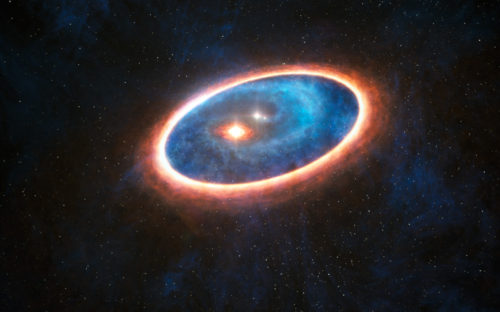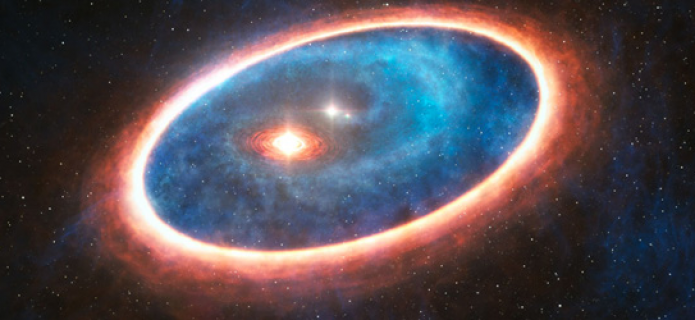Planet-forming Lifeline Discovered in a Binary Star System
For the first time, researchers using ALMA have detected a streamer of gas flowing from a massive outer disc toward the inner reaches of a binary star system. This never-before-seen feature may be responsible for sustaining a second, smaller disc of planet-forming material that otherwise would have disappeared long ago. Half of Sun-like stars are born in binary systems, meaning that these findings will have major consequences for the hunt for exoplanets. The results are published in the journal Nature on October 30, 2014.
A research group led by Anne Dutrey from the Laboratory of Astrophysics of Bordeaux, France and CNRS used the Atacama Large Millimeter/submillimeter Array (ALMA) to observe the distribution of dust and gas in a multiple-star system called GG Tau-A [1]. This object is only a few million years old and lies about 450 light-years from Earth in the constellation of Taurus (The Bull).
Like a wheel in a wheel, GG Tau-A contains a large, outer disc encircling the entire system as well as an inner disc around the main central star. This second inner disc has a mass roughly equivalent to that of Jupiter. Its presence has been an intriguing mystery for astronomers since it is losing material to its central star at a rate that should have depleted it long ago.

Fig. 1: This artist’s impression shows the dust and gas around the double star system GG Tauri-A. Researchers using ALMA have detected gas in the region between two discs in this binary system. This may allow planets to form in the gravitationally perturbed environment of the binary. Half of Sun-like stars are born in binary systems, meaning that these findings will have major consequences for the hunt for exoplanets. Credit: ESO/L. Calçada
While observing these structures with ALMA, the team made the exciting discovery of gas clumps in the region between the two discs. The new observations suggest that material is being transferred from the outer to the inner disc, creating a sustaining lifeline between the two [2].
"Material flowing through the cavity was predicted by computer simulations but has not been imaged before. Detecting these clumps indicates that material is moving between the discs, allowing one to feed off the other," explains Dutrey. "These observations demonstrate that material from the outer disc can sustain the inner disc for a long time. This has major consequences for potential planet formation."
Planets are born from the material left over from star birth. This is a slow process, meaning that an enduring disc is a prerequisite for planet formation. If the feeding process into the inner disc now seen with ALMA occurs in other multiple-star systems the findings introduce a vast number of new potential locations to find exoplanets in the future.
The first phase of exoplanet searches was directed at single-host stars like the Sun [3]. More recently it has been shown that a large fraction of giant planets orbit binary-star systems. Now, researchers have begun to take an even closer look and investigate the possibility of planets orbiting the individual stars of multiple-star systems. The new discovery supports the possible existence of such planets, giving exoplanet discoverers new happy hunting grounds.
Emmanuel Di Folco, co-author of the paper, concludes: "Almost half the Sun-like stars were born in binary systems. This means that we have found a mechanism to sustain planet formation that applies to a significant number of stars in the Milky Way. Our observations are a big step forward in truly understanding planet formation."
Notes
[1] GG Tau-A is part of a more complex multiple-star system called GG Tauri. Recent observations of GG Tau-A using the VLTI have revealed that one of the stars — GG Tau Ab, the one not surrounded by a disc — is itself a close binary, consisting of GG Tau-Ab1 and GG Tau-Ab2. This introduced a fifth component to the GG Tau system.
[2] An earlier result with ALMA showed an example of a single star with material flowing inwards from the outer part of its disc.
[3] Because orbits in binary stars are more complex and less stable, it was believed that forming planets in these systems would be more challenging than around single stars.
More Information
This research was presented in a paper entitled "Planet formation in the young, low-mass multiple stellar system GG Tau-A" by A. Dutrey et al., to appear in the journal Nature.
The team is composed of Anne Dutrey (University Bordeaux/CNRS, France), Emmanuel Di Folco (University Bordeaux/CNRS), Stephane Guilloteau (University Bordeaux/CNRS), Yann Boehler (University of Mexico, Michoacan, Mexico), Jeff Bary (Colgate University, Hamilton, USA), Tracy Beck (Space Telescope Science Institute, Baltimore, USA), Hervé Beust (IPAG, Grenoble, France), Edwige Chapillon (University Bordeaux/IRAM, France), Fredéric Gueth (IRAM, Saint Martin d’Hères, France), Jean-Marc Huré (University Bordeaux/CNRS), Arnaud Pierens (University Bordeaux/CNRS), Vincent Piétu (IRAM), Michal Simon (Stony Brook University, USA) and Ya-Wen Tang (Academia Sinica Institute of Astronomy and Astrophysics, Taipei, Taiwan).
The Atacama Large Millimeter/submillimeter Array (ALMA), an international astronomy facility, is a partnership of the European Organisation for Astronomical Research in the Southern Hemisphere (ESO), the U.S. National Science Foundation (NSF) and the National Institutes of Natural Sciences (NINS) of Japan in cooperation with the Republic of Chile. ALMA is funded by ESO on behalf of its Member States, by NSF in cooperation with the National Research Council of Canada (NRC) and the Ministry of Science and Technology (MOST) in Taiwan and by NINS in cooperation with the Academia Sinica (AS) in Taiwan and the Korea Astronomy and Space Science Institute (KASI).
ALMA construction and operations are led by ESO on behalf of its Member States; by the National Radio Astronomy Observatory (NRAO), managed by Associated Universities, Inc. (AUI), on behalf of North America; and by the National Astronomical Observatory of Japan (NAOJ) on behalf of East Asia. The Joint ALMA Observatory (JAO) provides the unified leadership and management of the construction, commissioning and operation of ALMA.
Contact:
Anne Dutrey
Laboratoire d'Astrophysique de Bordeaux
University Bordeaux/CNRS - France
Tel: +33 5 57 776140
Email: [email protected]
Emmanuel DiFolco
Laboratoire d'Astrophysique de Bordeaux
University Bordeaux/CNRS France
Tel: +33 5 57 776136
Email: [email protected]
Valeria Foncea
Education and Public Outreach Officer
Joint ALMA Observatory
Santiago, Chile
Tel: +56 2 467 6258
Cell: +56 9 75871963
Email: [email protected]
Richard Hook
Public Information Officer, ESO
Garching bei München, Germany
Tel: +49 89 3200 6655
Cell: +49 151 1537 3591
Email: [email protected]
Charles E. Blue
Public Information Officer
National Radio Astronomy Observatory
Charlottesville, Virginia, USA
Tel: +1 434 296 0314
Cell: +1 434.242.9559
E-mail: [email protected]
Masaaki Hiramatsu
Education and Public Outreach Officer, NAOJ Chile
Observatory Tokyo, Japan
Tel: +81 422 34 3630
E-mail: [email protected]

